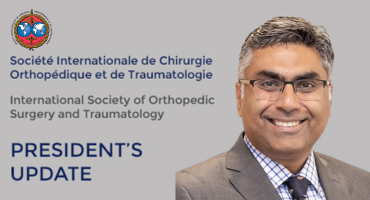
History of Orthopaedics
The History of Orthopaedics in the Czech Republic
 Prague, Czech Republic |
|
Trauma and Orthopaedics is a branch of surgery that deals with musculoskeletal injuries and diseases including the diagnosis and treatment of congenital and acquired limb deformities. It has always been considered as part of general surgery until the 20th century when it began to be recognised as a separate specialty. Some famous universities in Vienna started lecturing on orthopaedics as early as the year 1900. However, the orthopaedic discipline in the Czech Republic separated completely from surgery in 1971.
Following the establishment of the orthopaedic institutes in Würzburg (1816), Paris (1825), Berlin (1826) and Montpellier (1828), a similar medical institution led by associate professor Špotta was created in Prague in 1841. Dr Matějovský also worked in Prague as an associate professor of orthopaedics in a historic building that later became the 2nd orthopaedic clinic at Charles square within the existing paediatric surgery clinic.
Prof Eduard Albert in Vienna and his student and colleague Prof Karel Maydl (the real founder of Czech surgery) dealt regularly with orthopaedic patients. Prof Maydl performed the first spinal laminectomy in the world in 1882 using a special chisel of his own design. He described the irreducible congenital dislocation hip joints and adolescent epiphysiolysis of the femoral head. He was a pioneer in the development of the field of Traumatology and, after his arrival at Prof Weise’s clinic in Prague, he fought hard for the establishment of antisepsis in surgery. His students were Prof Kukula (Head of the First Surgical Clinic) and Prof Jedlička (Head of the Second Surgical Clinic). Prof Jedlička cared for the disabled and hence founded The Jedlička Institute for physically disabled young people in Prague. All three surgeons contributed to the introduction of antisepsis in surgery which was important in developing bone surgery. Prof Kukula’s pupil, Prof Tobiášek, was appointed Head of the Prague Orthopaedic Clinic in 1927. Prof Jedlička’s pupils were Prof Zahradníček and Prof Hněvkovský.
The development of modern orthopaedics in the Czech Republic was led by Prof Zahradníček in 1933 when he became in charge of the Prague Orthopaedic Clinic (today 1st Department of Orthopaedics, 1st Faculty of Medicine, Charles University in Prague and Motol University Hospital). In 1945, his collaborator, Prof Hněvkovský, became the head of the second orthopaedic clinic in Prague (today Department of Orthopaedics, 2nd Faculty of Medicine, Charles University in Prague and Motol University Hospital). This followed the footsteps of the German orthopaedic clinic of Prof Springer (founded in 1940). One of the most famous papers written by Prof Hněvkovský was "Patella alta congenita tarda". The Hněvkovský apparatus for treatment of developmental dysplasia of the hip (DDH) is also well known.
Some of the other great contributors to orthopaedics in the Czech Republic include the founder of the 1st Orthopaedic Clinic in Brno, Prof B. Frejka, who is known for his Frejka pillow/splint used in treating DDH, Prof Pavlíka from Olomouc who introduced the Pavlik Harness, Prof Polívky from Pilsen who specialised in treating bone and articular tuberculosis and Prof Vavrdy from Hradec Kralove who introduced the Hradec apparatus.
Other prominent figures include Prof S. Popelka who was the founder of the Czech and Slovak surgery and rheumatology (2nd Head of the Second Orthopaedic Clinic in Prague), Prof O. Čech who was the Emeritus Head of the Orthopaedic and Traumatology Clinic, FNKV Vinohrady and one of the founders of modern osteosynthesis on a European scale and Prof O. Vlach who was the Emeritus Head of the 2nd Orthopaedic Clinic in Brno and founder of modern spondylosurgery in the Czech Republic. We must not forget also Prof Hanausek who was the creator of the imperfect apparatus for the treatment of the DDH.
The highest professional body in the field of orthopaedics is the Czech Society for Orthopaedics and Traumatology which was founded in 1992. Since its inception, the society has been issuing its own journal: Acta chirurgiae orthopaedicae et traumatologiae Čechoslovaca. Prior to that, the Czechoslovak Society of Orthopaedics, which was founded in 1926, was publishing its own collection of work. However, since the 1990s, the combined society got divided into the national orthopaedic societies of the Czech Republic and Slovakia.















